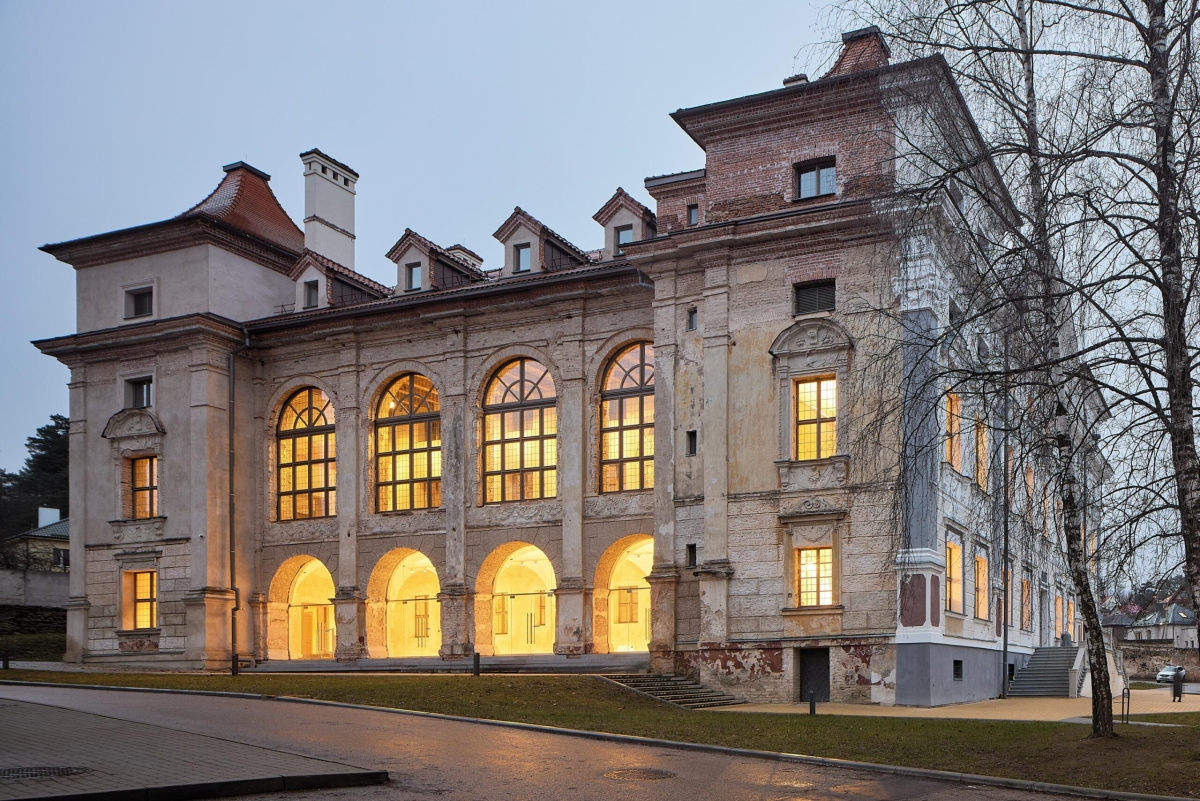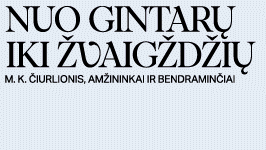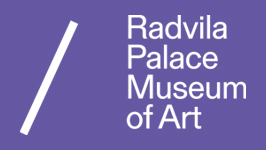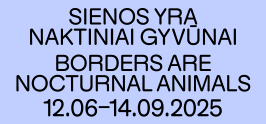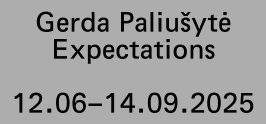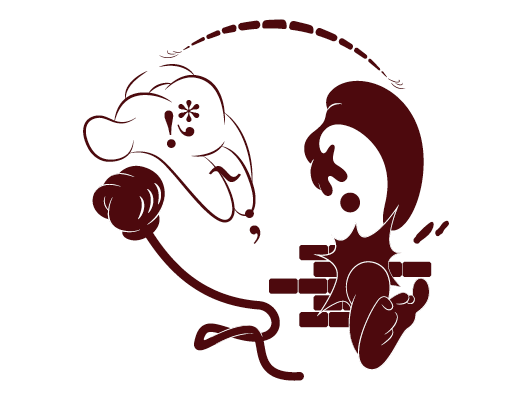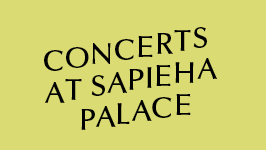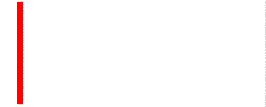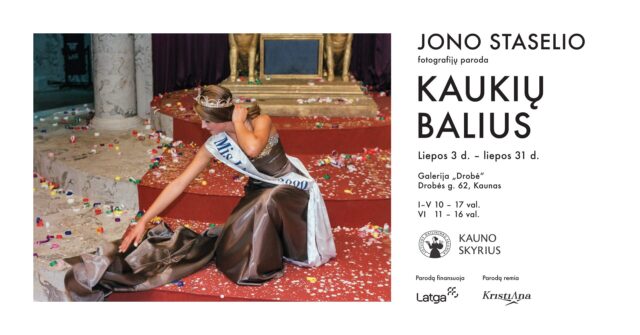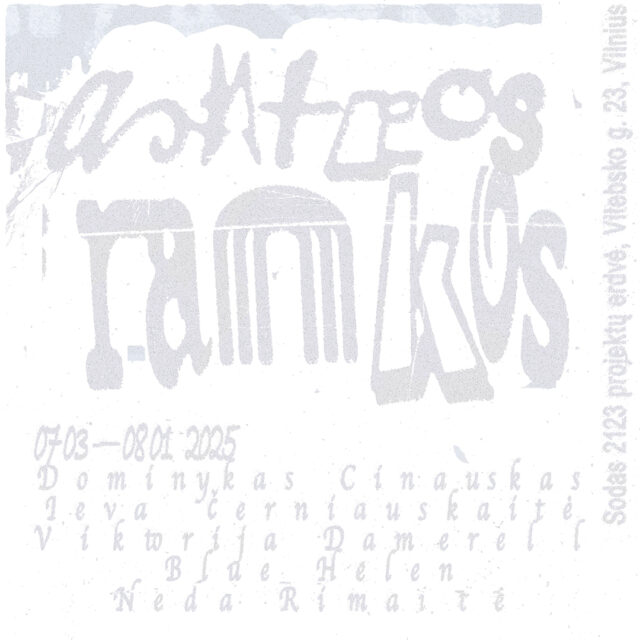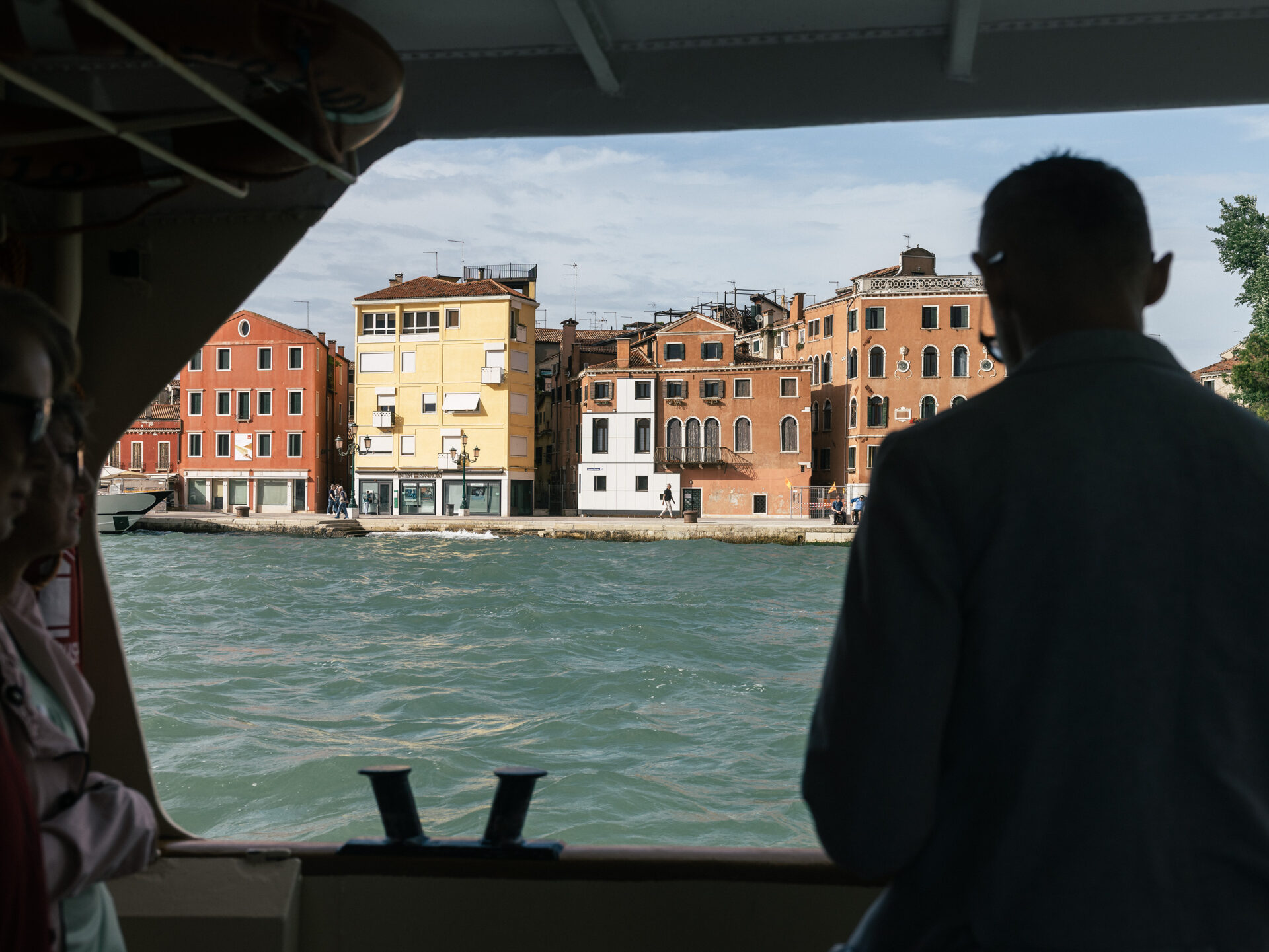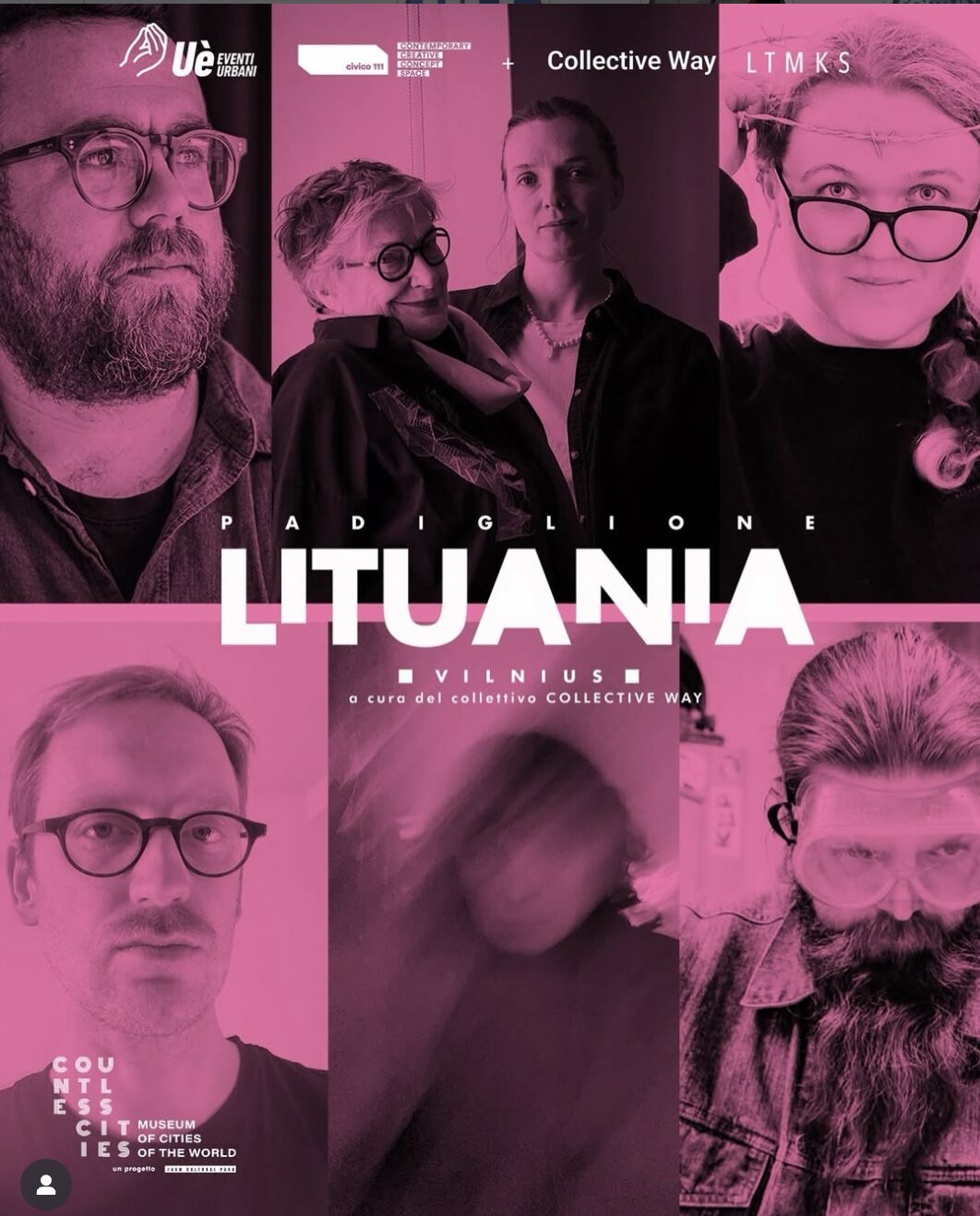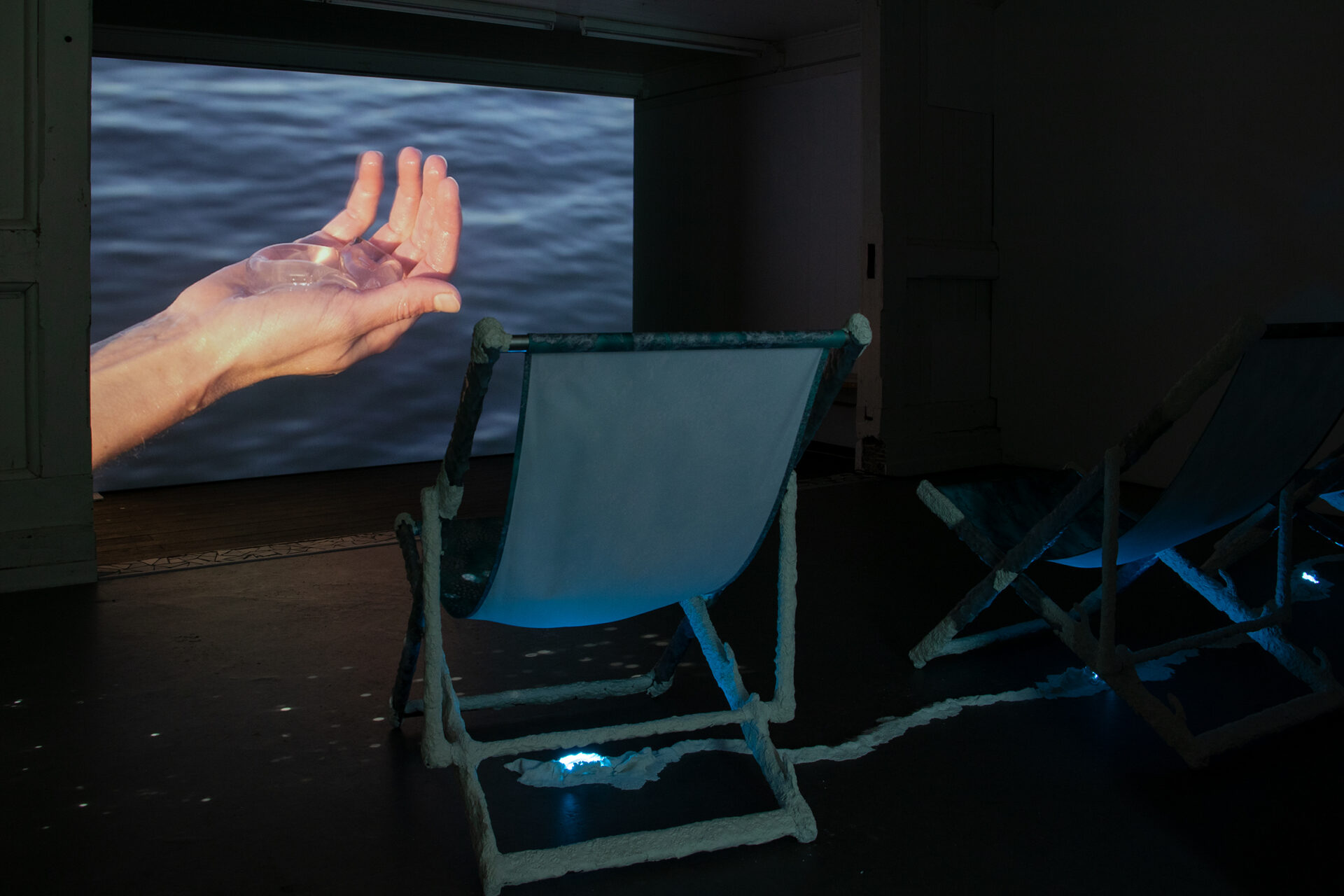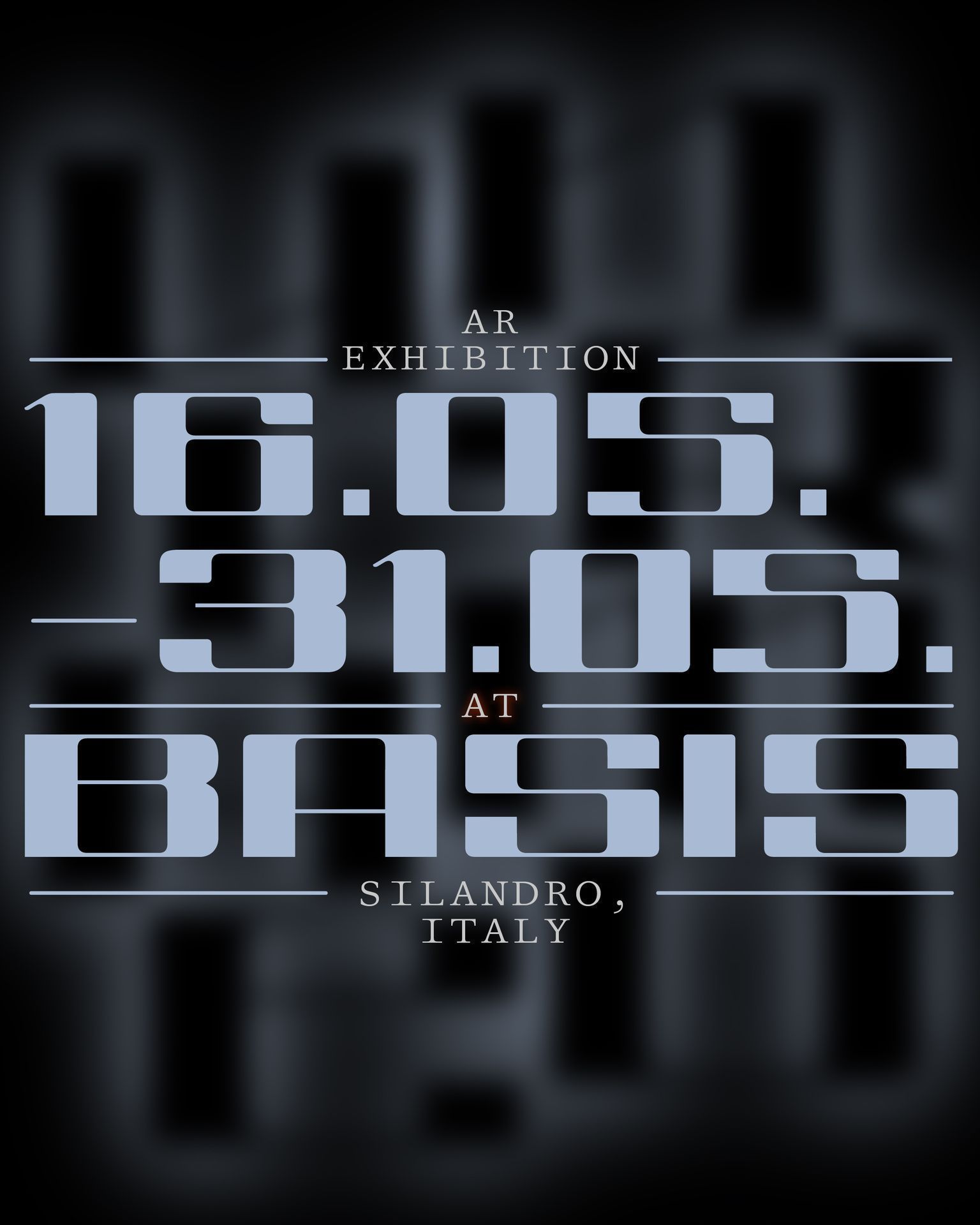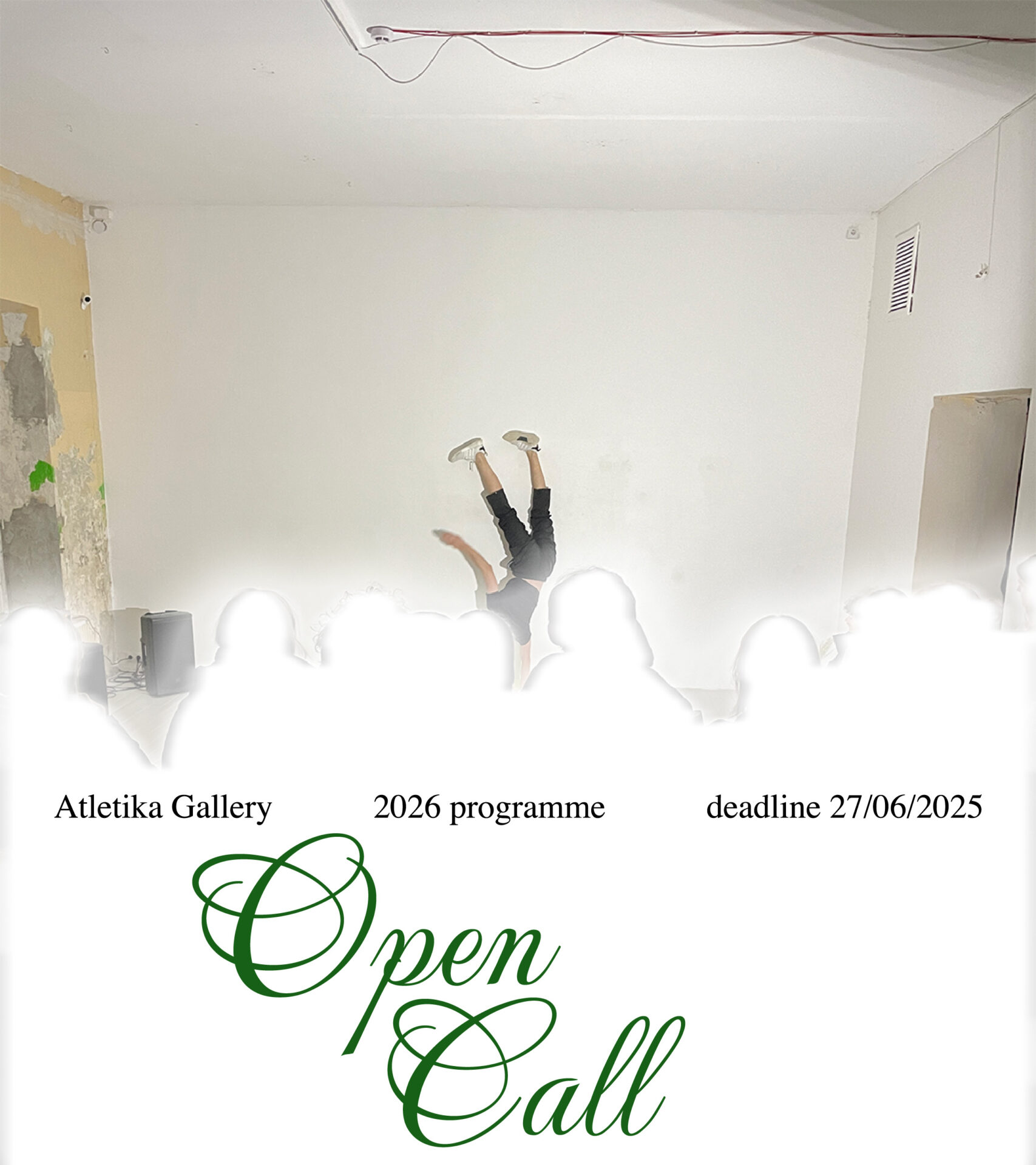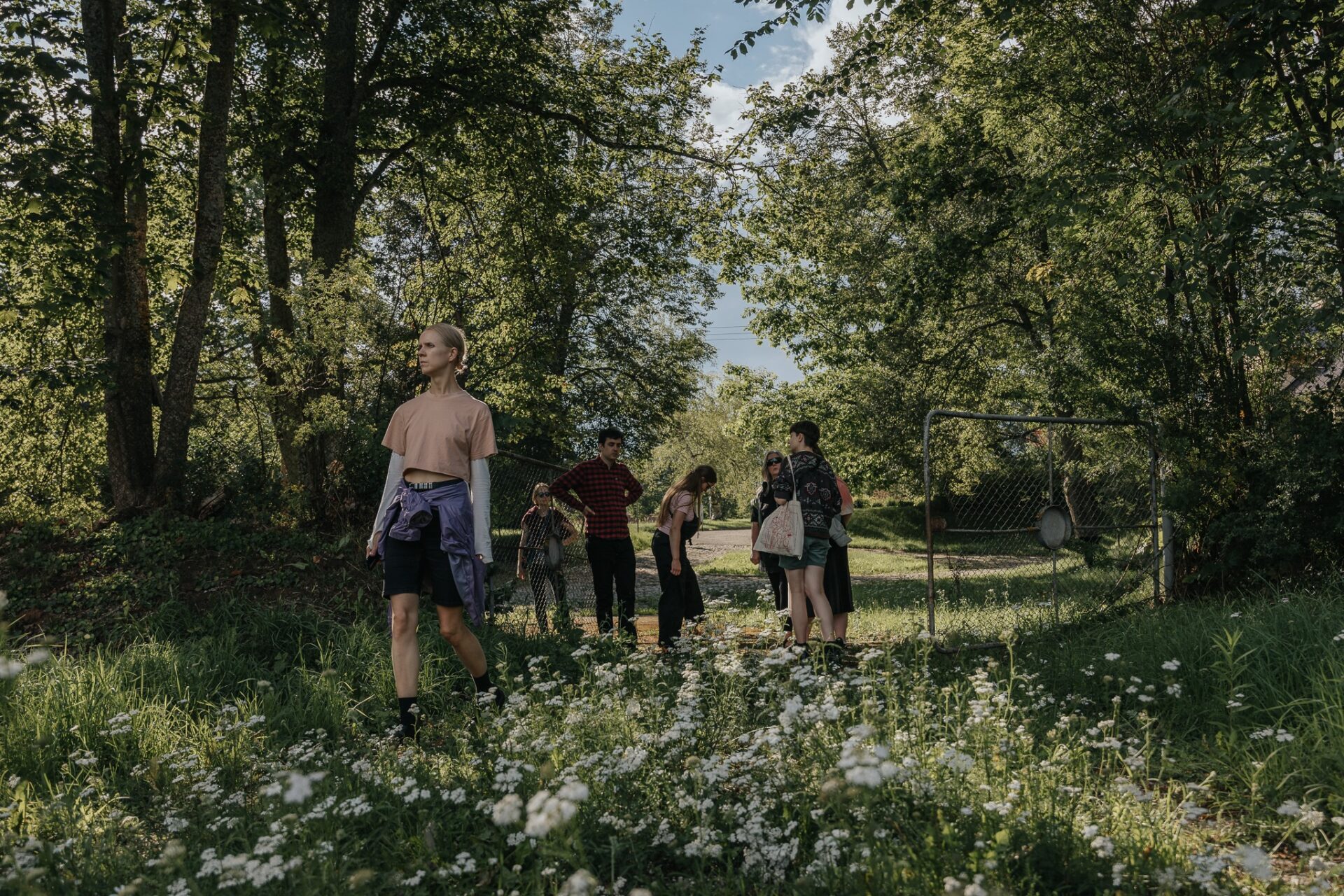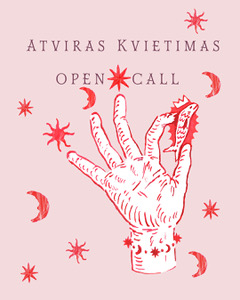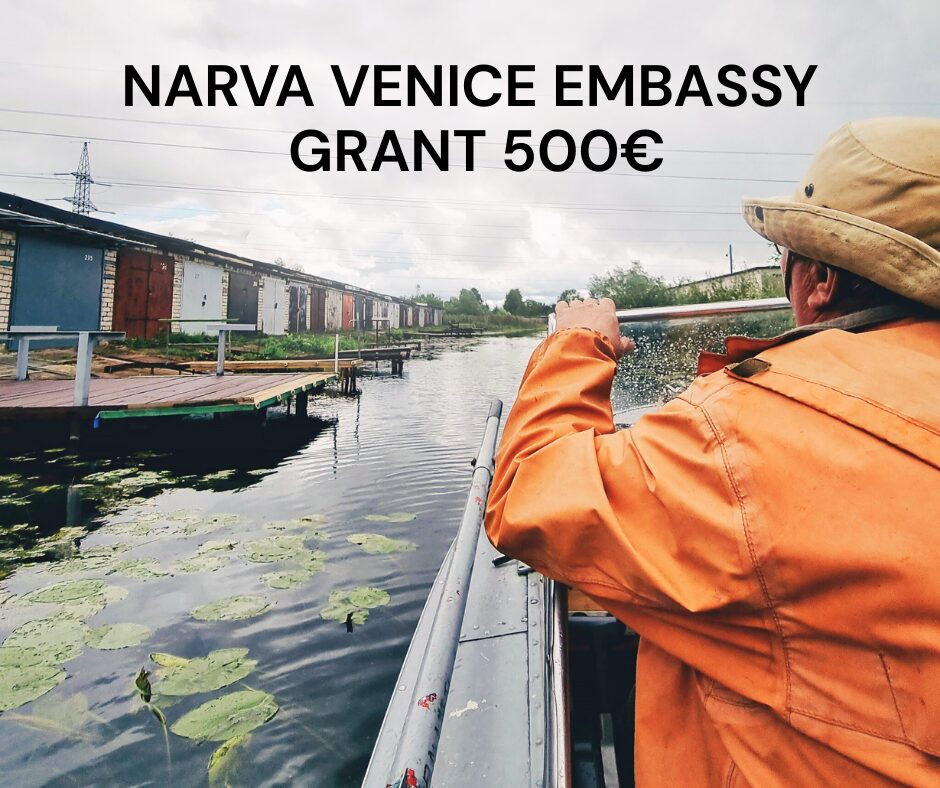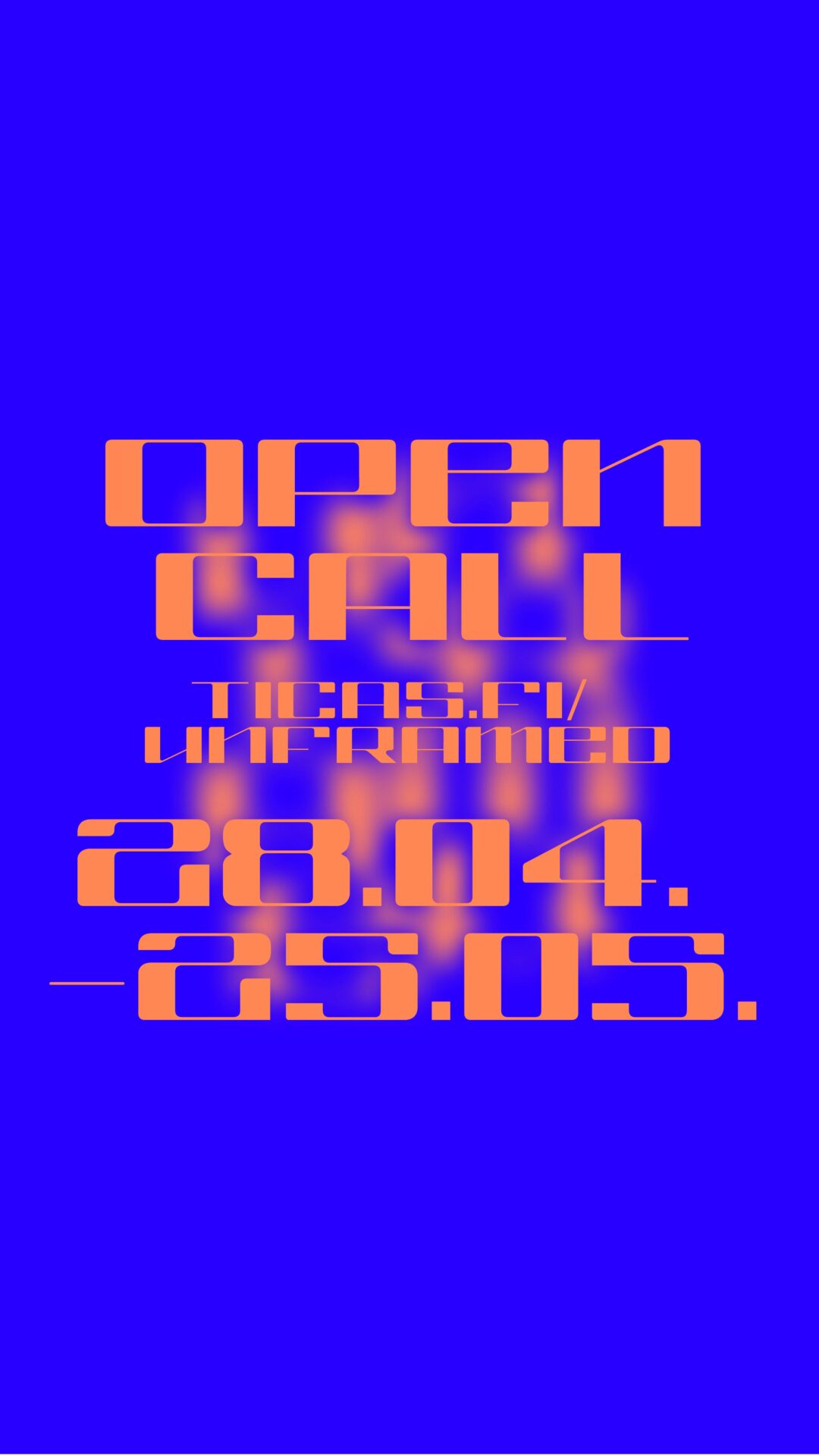The Japanese language has the term komorebi. It refers to sunlight shining between the leaves of trees. Despite the mesmerising flickering, this phenomenon also reminds us that the light reaching us through foliage, the ozone layer, and other cosmic filters, is in fact solar sediments delayed, on average, by eight minutes and 20 seconds. This is the time that a fresh burst of light and heat takes to travel the distance of 146.9 million kilometres to the Earth. Yet the solar souvenirs that are becoming increasingly harsh every year suggest cracked filters and a declining resilience.
Thinking about the Sapieha Palace, the new branch of the Contemporary Art Centre, and its first exhibition ‘Refuge’ (curated by Virginija Januškevičiūtė and Edgaras Gerasimovičius) became an endless komorebi in the vaults of my mind. News of the finished, more than decade-long, restoration of the Baroque palace, the need for greater heritage exposure, and the joy of finally having our own palazzo with prime contemporary art, was interspersed with publicly expressed doubts about the poor handling of the renovation work, incongruous details (sockets, heaters, floors, stairs, etc), and never-answered questions regarding the decision to give the administration of this asset to the CAC, of all institutions. Like two Baroque sisters, the light and shade of its public reception further boosted the event’s importance and the first impressions, which left one hoping that the glue of light will always keep the reality together somewhat more firmly.
Open to the public since 12 April this year, the Sapieha Palace absorbs light through its huge windows, and light is the exhibition’s poetic arrow, which pierces the twinkling surfaces of the works and the glimmer of ideas. Light really becomes powerful, all-connecting matter here, a token of a new beginning and a belief in a miracle, but it can even obscure some things, while highlighting others with its intensity, or become a tool for whitewashing. Bright light blinds. It is perhaps no mere coincidence that the building, which has been a landmark in the suburb of Antakalnis for over three centuries, served successively as a summer residence, a barracks and a military hospital, while in the interwar period it housed an eye clinic. In a sense, earlier experiences are coming back: the new incumbents are indeed committed to providing care for our imagination, inflamed by the war next door, teaching us to observe and marvel at the dialogue between heritage and contemporaneity, and striving to be transparent themselves.
Still, there is a risk here of a Baroque trompe l’oeil, an artistic spatial illusion device used to trick viewers into believing that objects depicted on a flat surface are real and that an almost infinite space unfolds behind them. Likewise, after the inaugural halo dissipates, the palace will inevitably have to assure the public that it is not merely a real estate agency that manages spaces for formal and commercial purposes. A more specific programme at the new institution, as well as clearly defined objectives and fields of activity, would help to avoid this impression. These are arguably still missing, as the institution’s self-positioning is limited to a fairly abstract definition of a multifunctional cultural educational centre that will offer cultural activities catering to the needs of contemporary society. With regard to the endless public debate on what is included in the notion of culture and what is not, the concept of a cultural education centre sounds particularly problematic.
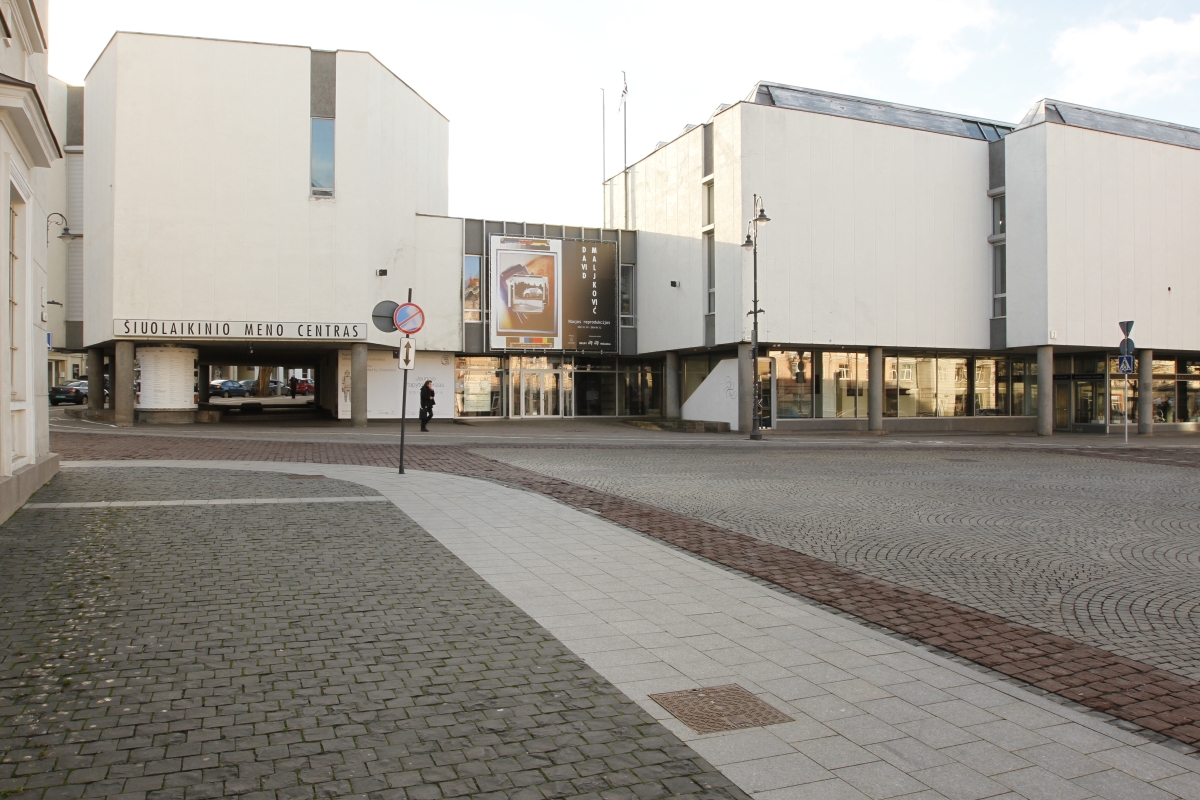
CAC fascde, 2013. Photo from CAC archive
This article is also being written at the peak of the bright period of the calendar year, at a convenient halfway point between the end of the renovation of the whiter-than-ever CAC building on Vokiečių Street and the first months of the new venue’s activity. The package of changes is complemented by the recent news of the CAC’s long-time director Kęstutis Kuizinas winning a competition to head another new institution, the National Institute of Architecture, which will cause major paradigm shifts on top of the infastructural refurbishing of the CAC. The programme, working methods and positioning of the art institution proposed by the future new head will contribute to the redistribution of power, and influence the centre’s coordinates in the local and international art fields. This is a pivotal moment. The expectations actively voiced by players in the field who usually paint changes in black or white, depending on personal interests, will be no less important. However, these processes require nuanced rather than categorical assessments, which are second in harmfulness only to the indifference that has emerged as a response to the CAC’s peculiarly elitist attitude over three decades. Hence, while histories of contemporary art in Lithuania are sporadically being written, and the changes far outrun their reflection, the new start of the CAC and its branch is a good opportunity to ponder, to ask questions, and to cautiously speculate about the intensity of the institution’s activities and the light of its ideas. How do we want our new or revamped institutions to function? What values do we want to promote, and what values do we want to discard? Is it possible to expect change when the common operating practice is contextually tied to a strong public image legacy? Are we witnessing someone’s end or beginning?
In his article ‘In the Thick of It. What Does the Present Want from Us?’[1], published four years ago by Artnews.lt, the curator Adomas Narkevičius positioned the CAC within the capacious concept of a microtopia. The author employed it to refer to a space that was not fully subject to the existing social, cultural and economic reality of the times. ‘It builds its own micro-world by choosing and invoking the institutional organisations and artistic instruments determined by its own members,’ Narkevičius wrote. Three decades ago, such an ambitious and perhaps even impudent tactic of operations undoubtedly unsettled orthodox art convictions, but perhaps that was exactly what helped to establish contemporary art in Lithuania, not as marginalised opposition to the already-existing concept of art, but as an autonomous vector in line with international processes. I would dare to say that, in a certain sense, it was a crucial and necessary political tool that was vital in breaking away from the outdated ideological apparatus, raised a generation of daring and unconventional artists, and, according to Narkevičius, ‘set the initial trajectories, arranged the guideposts, and drew demarcation lines in the local contemporary art field’.
Curiously, during its first decade, despite lacking long-term experience and a tradition of contemporary art administration, as well as clear operational protocols, the CAC managed not only to institutionalise contemporary art, which was still quite foreign to the public, but also to redefine a contemporary art institution in sync with the Nordic countries, the Netherlands and Germany. The CAC’s starting position was favourable for such an objective, as it coincided with an attempt at self-discovery through experimentation, rather than changing something that was still non-existent in Lithuania. The New Institutionalism (a term borrowed from economics and sociology) which emerged as a novel curatorial and administrative model in the aforementioned countries in the late 1990s manifested itself as the curators’ efforts to reconfigure art centres and kunsthalles as active, open, democratic and egalitarian public spaces, emphasising the multifunctionality of institutions and the pursuit of decentralising the exhibition genre in relation to their other activities.
The New Institutionalism was also concurrent with the curators’ appropriation of institutional critique, practised by artists in Europe and the USA since the 1970s, which in turn reinforced the position of the curator as an actively creating author. The CAC used this feature of New Institutionalism by entrenching the names of several curators whose mythology continues to define the name of the institution itself to this day. Yet unlike other centres, which changed the institutional structures and their hierarchies, trying the open social organisation role, the CAC opted for open insularity as its political course. The then-new art formation outpaced the governing institutions that were supposed to discipline it, legal acts, and art criticism and theory. The centre’s tacit resistance to subordination, fairly inert movement along the chosen vector, strict selectivity in relation to the members of its community, and an idiosyncratic legal status that did not fit the definitions of a museum or a cultural centre, and ultimately the indefinite tenure of the director, resulted in a slow rotation of people who represented and headed the institution, the postponement of responsibilities, and a certain inviolability.

CAC reconstruction, 2024. Photo from CAC archive
This situation also questions the responsibility of the Ministry of Culture for all terms of office (according to the statute of the CAC, it is owned by the state, while the institution implementing the owner’s rights and obligations is the Ministry of Culture). On one hand, it should be the cornerstone of the institutional milieu that governs and supervises the administrative apparatus of the centre and other organisations subordinate to it, shaping mechanisms of change as much as those of stability. On the other hand, the ministry itself becomes a hostage of laws and amendments that are passed too slowly.[2] Among other things, the fairly dismissive and occasionally even derisive public attitude towards the Ministry of Culture in the context of other ministries leads to a situation where the same protocols that are followed fanatically in the supervision and governance of the rest of the public sector are often rendered null in the field of culture, often leaving it to inertia and self-regulation. As culture is still widely perceived by the general public as a decorative and symbolic sphere, and decision makers are reluctant to listen to culture professionals, it is just a question of time whether the ministry will be merged with the Ministry of Education, Science and Sport, for example, when defence issues are the top priority of the country.
Further considering the influence of New Institutionalism, the CAC is mentioned among examples of its application with the ‘CAC TV’ project (2004–2007), through which the institution demonstrated its ability to curate content beyond the white cube. This practically confirmed the assumption that it is not the building of an institution that defines the art displayed in it; rather, the methods of content-making determine the identity of an institution, no matter where it is. Proof of this is the abbreviation CAC itself, which over the last three decades has become entrenched in popular parlance as a generic designation for contemporary art (or art deemed weird by the viewer). An essentially similar transference of meaning is happening in the case of the Sapieha Palace, for which merely a new, or more precisely heritage, architectural casing is not enough to adapt the way of presenting art as well. The conceptual ‘radiation’ accumulated by the CAC over a long time is too strong to allow a radical conversion of the software simply by switching the hardware.
To be sure, there was an ambition to create a new institution unlike any other in Lithuania, and this was voiced publicly on a number of occasions. ‘We are building a place that is missing not only in Vilnius, but in the whole of Lithuania, a place we lack,’[3] Dr Gintautė Žemaitytė, the head of the Sapieha Palace branch of the CAC, claimed in an interview. The pronoun ‘we’ contains more than just the CAC administration. In the spring of 2022, I was invited to take part in an online workshop called ‘Sapieha Palace Actualisation: Creating a Cultural Education Centre’. The CAC team and Xwhy / Agency of Understanding several times brought together experts from various spheres of culture and employees of cultural institutions, as well as representatives of the local Antakalnis community, to work on the vision of the Sapieha Palace. It is difficult to say whether the generous brainstorming of ideas and writing them down in multi-level tables has been productive, but so far, the publicly declared institutional vision does not appear to have moved from the point announced two years ago. Nevertheless, certain processes are under way, and it is likely that the branch will eventually be pressed to demonstrate that it follows somewhat different principles of operation compared to the central headquarters, if not outright competing with the latter. The Sapieha Palace learning community initiative, which delivers a promise of collective creation of a body of knowledge based on the spirit of the place, and a more open institutional model without even defined specific learning methods or so-called programme tutors, can be mentioned as the first effort of this kind. The fruitful cooperation between contemporary art, scholarship and institutions can indeed promote a dialogue between different fields and research methods, as well as the emergence of new knowledge; but this will take not only agents from the CAC’s circuit, but also heritage and cultural history experts.
Still, the administration’s wish that the palace should be unlike any other cultural institution is very conditional, since at least two existing institutions have been referred to as role models. The working group formed by the Ministry of Culture in 2017 proposed that the Sapieha Palace should house a Cultural Education Centre, an allusion to the Centre for Civil Education which opened in 2016. On considering which of the institutions under the ministry could implement this idea, it was decided to entrust the Contemporary Art Centre with the task. Kęstutis Kuizinas revealed in an interview that he had asked the then minister of culture Liana Ruokytė-Jonsson (in office from 2016 to 2018) and her team why the ministry had chosen the CAC in particular, to which the ministry replied that their intention had been to have something interesting and future-oriented, rather than just another conventional museum in the city.[4]
It is also important to note the leap from the office of political decisions to an executive position by Gintautė Žemaitytė, who had served as a vice-minister under Ruokytė-Jonsson, somewhat predictable but softly cushioned by a single competition. One would hope that this instrumentalisation of political power was approved by all stakeholders, and will ensure the optimal performance of the new institution in the future. Although the current Law on Budgetary Institutions does not specify a term of office for the head of a structural subsidiary, the changing work culture will hopefully make the tradition of indefinite terms increasingly questioned, and eventually a thing of the past.
On the other hand, one wonders whether the choice of the CAC as the agent capable of consolidating the work of the Sapieha Palace was based solely on its undeniable national and international expertise. For some time now, there has been a growing feeling that the CAC is undergoing a certain moral and conceptual exhaustion, which calls for a reconsideration of its institutional model. Such a brief respite was supposed to be provided by the reconstruction of the building, which could have served as a test of whether the entity was visible only when it was on a hiatus. Still, as was mentioned earlier in this article, infrastructure constitutes only part of an institution, regardless of its importance to its identity. The invisible component has recently slowly shifted from evolution to involution: ideological contraction, decline and reduction. Narkevičius also notes this in his article: ‘Over the course of three decades, an external institutional and non-institutional milieu has developed that points to both the necessity and the opportunities to lead this field along completely different lines. This seems to suggest that the pull of this microtopia has diminished, and perhaps it has declined as a living concentrate of ideological and human commonalities that has an end.’
This is inevitably related to the emergence of new art initiatives, spaces and institutions, which began around 2008 and peaked in 2012–2016. Once an alternative to the artistic conventions dictated by the Artists’ Union, the CAC eventually triggered the advent of alternatives to itself by making quite hermetic decisions about what kind of art should be made visible and what was to be left out. The fact that the idea of the isolated space of museums, art galleries and art centres has gone out of fashion has exacerbated this situation, while our perception of contemporary art has also become worryingly outdated. These and many other factors, not necessarily related to the CAC, have naturally prompted a search for new art streams, trends, forms of presentation, and concepts of contemporaneity. The light of the CAC as a beacon of contemporary art has obviously diminished, which only proves that the Lithuanian art field has expanded its shores.
Yet this, too, raises new questions and leads to other extremes. The art field’s active pursuit of institutionalisation confirms the privileged status of the organisational model of an institution. Institutionalised activity is still perceived as self-evident, widely acceptable, resistant to change, and supportive of a hierarchical system and close ties with government structures. Paradoxically, the concept of an institution appears to be more stable than the category of art itself par excellence. Individuals who do not represent a particular institution are not always deemed fully fledged agents in the field, as if lacking a certain ‘organ’. Curiously, however, normative funding mechanisms force institutions to become increasingly homogeneous and multifunctional, with the content of their activity being oriented towards a progressively larger segment of society which often displays the same capacity for cultural consumption. While institutions and their growing diversity expand the landscape of contemporary art, more institutions means a more complicated system, and more regulation and coercion. In this context, the CAC’s territorial expansion may look like an attempt to reclaim the declining discursive power.

Sapieha Palace. Photo: Audrius Solominas
The activities in the Sapieha Palace also contribute to the curious and particularly intensified process of palacification, marked by art institutions inhabiting heritage objects. These include not just the Sapieha Palace as a new branch of the CAC, but also the Kirdiejai Palace, which is to house the Vilnius Museum, the Radvila Palace, which belongs to the Lithuanian National Museum of Art and is currently awaiting renovation, the recently restored Trakų Vokė Manor, and so on. Unlike the case of the Palace of the Grand Dukes of Lithuania, where the reconstruction of a non-surviving building divided the public and attracted political interests, these developments are seen as positive examples of heritage preservation and adaptation that draw attention to the country’s less visible historical legacy. Today many initiatives are not tied any more to the exalted official narrative of state culture as it used to be conceived, i.e. as saving the freedom of Lithuania and establishing the eternal foundations of statehood. It is nonetheless interesting to ponder how palaces, charged as they are with the power and vocabulary of historical privilege, will influence the processes of the administration of (contemporary) art and the attitude towards it, and ultimately how this symbolism will function in the face of the war raging nearby. Maybe it will spawn new visiting habits and talking regimes that will reconfigure image-making strategies, or alternatively it will further deepen the divide between these worlds of survival and celebration?
If the New Institutionalism lost its appeal because it failed to problematise the notion of institutions, perhaps this time of the emergence of new institutions and the transformation of existing ones is a good occasion to consider exactly what contemporary art and the organisational structure of its presentation are becoming today here in Lithuania. Given that the geography of art history is expanding, and its Western version is just one of many, while ours is no less important, and that art strives to confront historical injustices and to take into account social and political processes by making proposals, showing solidarity, facilitating the production of knowledge and networking, and bearing witness and encouraging participation, one could say that it is increasingly becoming an ethical activity. If this is true, this turn could mark the emergence of an ethical institutionalism that renounces worn-out tropes of power hierarchy and the politics of the one and only way to ‘the art world’. It is obvious that this kind of (art) world, and the scale of its problems we are facing today, demands a change of operating methods if we are to trust in it again.
The first exhibition at the Sapieha Palace, ‘Refuge’, has cast a spell, if not for systemic change, then at least for a bright future. This show indeed hints at a hopeful turn to miracles, faith, magical thinking, spells and enchantment, and a sentimental longing for alternative ways of living and being together. This thematic field, which has dominated the contemporary art scene for the last few years, meets the somewhat earlier motifs of care and psychologism, reflecting the disillusion with ideas of reason and progress evident in Western culture today. Human culture increasingly appears dangerous and destructive rather than creative. Perhaps that is why magic often replaces science, faith stands in for knowledge, and ritual substitutes for rational action in our everyday life. On which side of these binaries art falls is another question.
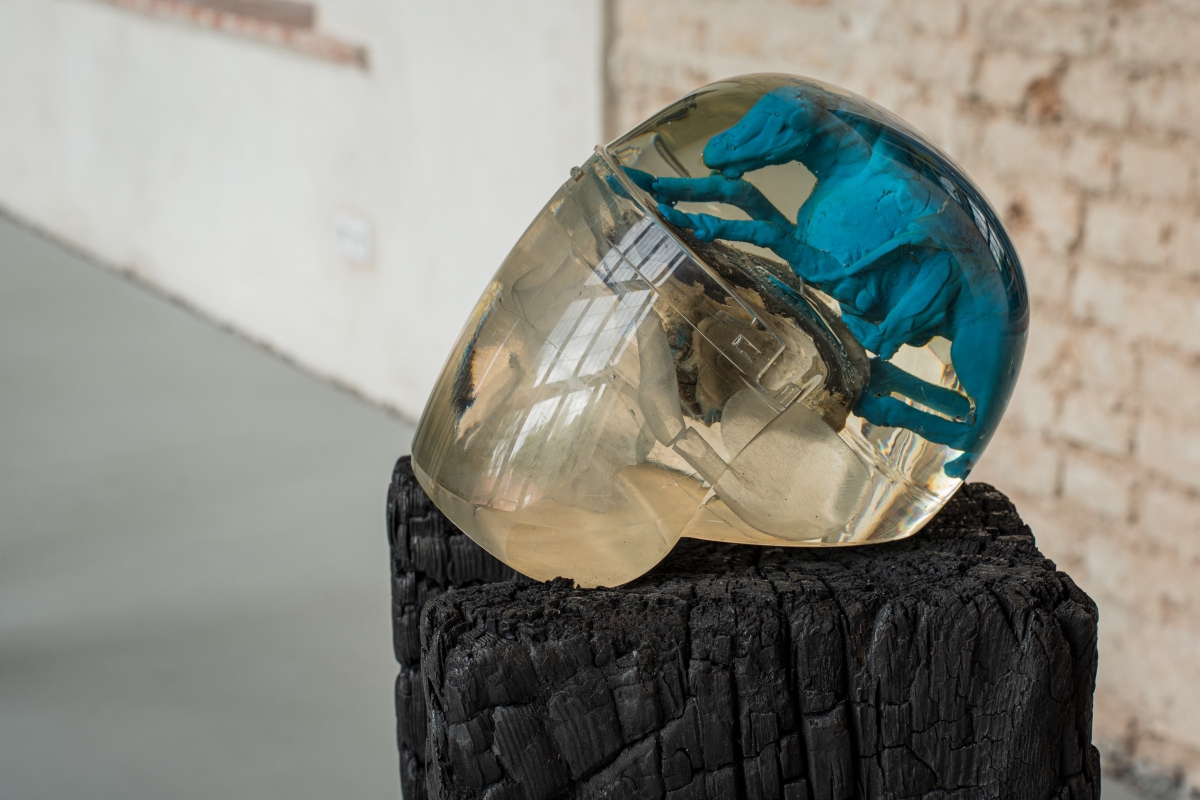
Petras Mazūras. Double Race, 2020. Mixed media, 27 × 20 × 37 cm and a fragment of a wooden wall: 102 × 28,5 × 23.5 cm. Photographer: Andrej Vasilenko
The direction chosen by the curators is a timely and sensitive response to the anxiety caused by ongoing wars and their escalation. But we should not forget that this time, fed by Ukraine aid packages, is also capable of expanding and contracting. The exhibition opened before 24 April, when the US Senate passed the $95 billion foreign aid bill, and it is no wonder that anxiety, or perhaps resignation, could have become the third curator in putting the show together. The display could have had an absolutely different effect on those who had a chance to view it during the first weeks. This ability to refract light according to the changing degree of hope and context is one of the exhibition’s fascinating qualities.
Yet it is precisely this curation of the atmosphere that begins to dominate the exhibition’s other declared themes. The show is said to be a meditation on Baroque, as well as bringing to light the different narrations of the palace’s history, but these lines remain hypothetical, lacking direct references or more extensive curatorial navigation between the chosen works and historical facts. Links with roughly marked past uses of the palace are schematic at best: for instance, Petras Mazūras’ sculptures illustrate the barracks stage, while drawings done with closed eyes on her sick bed by the late artist Alina Popa allude to the hospital one.
Experiencing an overview of the palace’s history through works of contemporary art is a challenging task, particularly if one has not taken part in any of the guided tours of the premises offered. Although descriptions of works might have come in useful in this respect, they mention just a few such associations, while most others are abstract and distant. Hence the reader is left to enjoy the stories behind the creation of the works and their interpretation, sensuously written by the curators in rich poetic language. Describing works anew in this article makes no sense, so it is much more interesting to question the motives behind the selection of the works and the ways of combining them, which, in line with the chosen motif of spells, often appear mysterious too.
Although this curatorial gesture can be related to the incoherence of historical narratives and visitors’ freedom to come up with their own individual storylines, this hinders the promise of connecting past and present discourses. After all, the first exhibition often becomes a benchmark for later activities. Time is an interpretational category that defines every person’s experience. Failure to provide a chronological compass and conceptually engage with the historical coordinates in exhibitions and the rest of the programme puts the institution at risk of dehistoricising the heritage to a merely expedient infrastructure: refurbished walls and ceilings. The ground floor historical capsule, intended to compensate for this, so far looks too modest. What, then, will set the exhibitions at the institution’s headquarters apart from the ones at the subsidiary, if such a constellation of works can easily be pictured in the CAC’s white cube?
The aim to help the palace reveal itself as an architectural exhibit with the first display was implemented successfully, unlike the ‘Refuge’ exhibition itself, whose conceptual base appears too fragile and blown over by the almost elemental effect created by the building. The curatorial decision to place works of contemporary art in a heritage object in a discreet and non-invasive way is overshadowed by the intense environment, giving an impression of a sparse collection of works scattered around the palace that have difficulty forming a coherent whole.
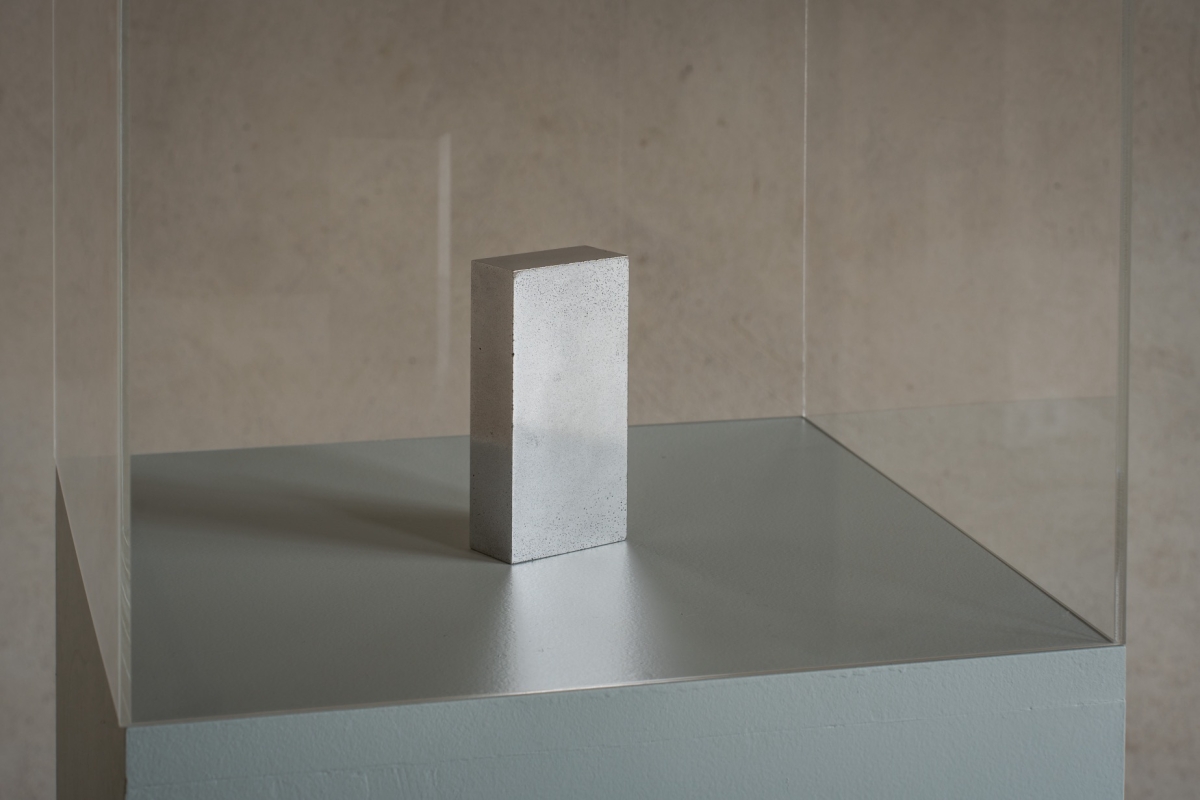
Darius Žiūra. Mould, 1998 / 2013. Coins collected in fountains, 15 × 7.5 × 3.75 cm. Photographer: Emilija Filipenkovaitė
Perhaps this is why Darius Žiūra’s Mould, displayed at the beginning of the exhibition, is a tuning point not just for ‘Refuge’, but also for the institution itself. The conceptually capacious work is an alloy of coins harvested by the artist from the main fountain in the seaside resort of Palanga, a small monument to the ritual meaning originally attributed to these ‘good luck’ coins, like a brick for a beacon of happiness or for the road to the Land of Oz. Although the alloy of different metals was not expected to be technically possible, the coins tossed into the fountain by tourists from various countries eventually fused into a shiny rugged composite. Likewise, the impression made by the first exhibition makes the Sapieha Palace look like a compound of the experiences of diverse institutions and initiatives. It synthesises the activities of the Aikas Žado Laboratory, responsible for the restoration and conservation of the 18th-century Žeimiai Manor (Domas Noreika, the founder of the laboratory, works at the palace as a restoration expert), while the conceptual and aesthetic agenda of the works selected for the exhibition fluctuates between the CAC’s trademark approach, the defunct Swallow exhibition space, and the Medūza contemporary art and culture space of the Lithuanian Artists’ Association. This only confirms the spell that if you toss these different coins into a Baroque fountain and revisit it later, you will probably still find them there, provided that municipal employees or an artist have not collected them. Thus, it is hardly possible to conjure up something new by fusing established entities from the art circuit. Nevertheless, Žiūra’s Mould shows that the result can be unexpected and even very satisfying! The sundial will tell.
Still, the impression left by the fusion in this exhibition is twofold. Some of the works induce genuine delight, even if they are quite straightforwardly rhymed based on the aesthetic denominator of light and radiance, as if focusing solely on their ‘shining’ qualities. A quick walk through the exhibition indeed reveals it as beautiful, however banal the term. Beside Žiūra’s sheeny bar of ‘charmed’ coins, Gintautas Trimakas’ lightography engages in a conversation with the glare of the sun captured in mundane landscapes by Vytautas Balčytis. Andrius Arutiunian’s intellectual and atmospheric work, resembling a suspended tongue trying to articulate old Armenian spells, connects through its brass surface with the grabbing and caressing hands of the sculptural installation by Iza Tarasewicz. The latter work also speaks through the curators’ lips about the Ukrainian grain export crisis, and brings the exhibition closer to today’s upheavals in the region with a light gesture, as if dispelling the exalted illusion of light. Ochre, a fluffy dust-like powder that leaves annoying stubborn stains on surfaces, displayed in wooden boxes next to the installation, fleetingly resembles the aforementioned solar sediments. Although the artist herself invokes them in order to allude to the toxicity of capitalism, this work could also epitomise any kind of harnessed power.
The almost century-old Futurist watercolour by Vladas Drėma depicting a fire in Vilnius extends its drawn flaming tongues to Mindaugas Lukošaitis’ impressive visions of a burning future. Nevertheless, it is a pity that the works of one of today’s most intriguing Lithuanian draughtsmen are presented in the exhibition as digital prints that extinguish the original hand quivers, make the colours look synthetic, and make the series resemble a comic strip. Petras Mazūras’ burnt wooden wall fragments, adorned with original contemporary resin amber containing inclusions of the horseman figure which symbolises Lithuanian nationhood, look like the aftermath of this hypothetical fire. One of the exhibition’s darkest rooms houses digital images of non-existent plants that require no light, created by Miljohn Ruperto and Ulrik Heltoft. Perhaps we are witnessing what is to come after the light expires? After a long time spent with the show, the choice of video works begins to raise questions. Projected by artificial light, they often look like pretentious and solipsistic foreign bodies, distant from the exhibition’s thematic fabric, dense as it is, seeking literal analogies with a countryside residence, joking peculiarly about time travel, and testing our duality. This is not to say that the works are inferior, but their selection introduces completely different registers that do not help consolidate the disparate material of the show.
All in all, we should acknowledge that life and art are neither perfectly separate nor precisely connected spheres. This time ‘Refuge’ has a solid architectural refuge that admittedly is a much stronger attraction. Another, much more complicated question is what kind of content will attract visitors to the palace when this exhibition scenography loses some of its initial appeal. Hopefully, history will not be turned into a period drama here and arbitrarily laid out in the eternal present, disregarding chronology and context. If the institution’s further activities and their model aim to continue the direction of the curation of light, it is worth noting that the latter comes close to a game of hide and seek, filtering the light, concealing, and creating screens, shades and shelters, for the sun also has its winds. Yet this is perhaps the only way to find where the new and renewed institution’s place under the sun is, and what reaches us only as sediments of the latter.
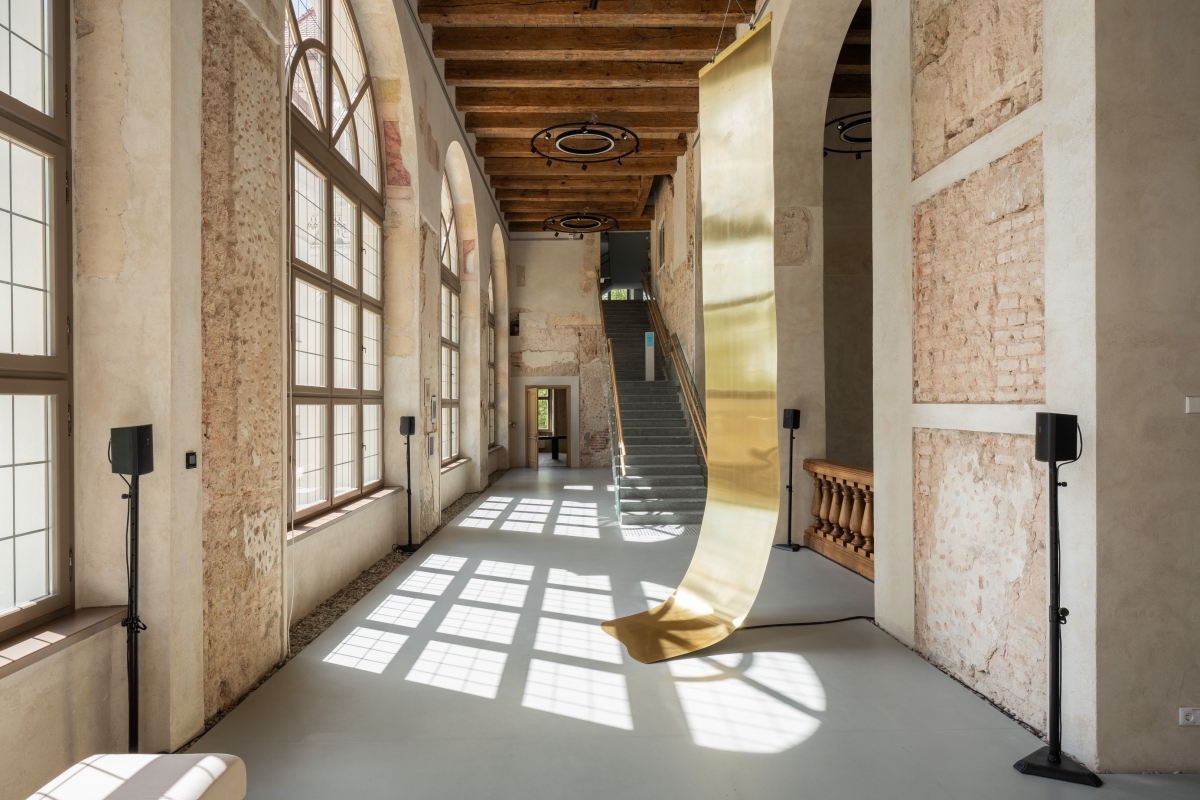
Refuge, exhibition view. Sapieha Palace, Vilnius. Photographer: Andrej Vasilenko
[1] Narkevičius, Adomas. ‘Ten, kur tiršta. Ko dabartis iš mūsų nori?’. Artnews.lt, 12 February 2020. http://artnews.lt/ten-kur-tirsta-ko-dabartis-musu-nori-55939.
[2] In response to a written inquiry regarding the competitions for the positions of the heads of the CAC and the Sapieha Palace subsidiary, the following comment was received from the Ministry of Culture. Only the relevant excerpt related to the terms of office of heads of public institutions is provided:
‘The Law amending the Law on Budgetary Institutions, which came into effect on January 1, 2024, stipulates that an individual can be appointed head of a budgetary institution for a 5-year term by means of a competition or, in specified cases, without a competition. Article 2, Section 7 of the Law specifies that heads of budgetary institutions who were appointed to office for an indefinite term prior to the Law coming into effect and have held the position of head of this budgetary institution for more than 10 years on the day of the Law coming into effect continue to hold the position of head of this budgetary institution for one year from the day of this Law coming into effect.’
[3] ‘Gyvai iš Sapiegų rūmų atidarymo. Sapiegų rūmai│Gintautė Žemaitytė’. Radio broadcast, Radio Vilnius, published on April 13, 2024. http://radiovilnius.live/sapiegu-rumai-%e2%94%82-gintaute-zemaityte/
[4] Markevičius, Vytautas. ‘Visuomenei atveriami Sapiegų rūmai: kvapą gniaužiantis iššūkis virsta realybe’. Bernardinai.lt, April 12, 2024. http://www.bernardinai.lt/visuomenei-atveriami-sapiegu-rumai-kvapa-gniauziantis-issukis-virsta-realybe/.
